After five years into the 1955 Modernisation Plan, the British Transport Commission (BTC) abandoned its original concept of diesel locomotive requirement, and began seeking a new single-engined Type 4 of more than 2,500hp, which could be mounted on a Co-Co wheel arrangement. This followed criticism of the poor power/weight ratio of the earlier 1Co-Co1 Type 4s ordered under the 1955 modernisation scheme.
The English Electric Co's candidate for the new Type 4 was DP2 - Diesel Prototype 2 - which emerged from the EE Co Vulcan Foundry in May 1962. It was essentially an enlarged version of the EE Co Type 3 Co-Co (later Class 37) the extra power being provided by the company's charged-cooled version of the 16-cylinder 16SVT engine uprated to 2,750hp.

(Above) Here DP2 is sporting the production 'Deltic'-type bodyshell (in overall green livery) with modifies louvers, and is seen heading the 'up' 'Manxman' through Rugby in July 1962. (Below) During trials on the LMR based at Camden shed DP2 passed its first year on a diagram covering a remarkable 3,600 miles per week, but in view of the LMR's impending electrification between Euston, Liverpool and Manchester, the loco was transferred to the ECML. During the summer of 1963, DP2 regularly covered 5,270 miles per week between Kings Cross and Edinburgh, taking the 10.10 each weekday from Kings Cross and returning overnight on the 22.30 from Edinburgh. As it turned out, DP2 was the most intensely utilized of the prototype Type 4s, which led to an order for fifty locomotives (Class 50) the first EE Co design to eliminate the characteristic nose ends on the company's Class 55, 37 and Class 40 fleet.
(Below) The privately-sponsored EE Co prototype DP2 was employed on the ECML to cover for the withdrawal of the Deltic fleet for train heating boiler modifications. Despite the rigorous Type 5 schedules, DP2 had a similar trouble-free spell of service as it had done on the WCML. Here the prototype is seen departing Kings Cross with the 9.50 for Newcastle on September 23rd 1963. Photo © GE-Alstom
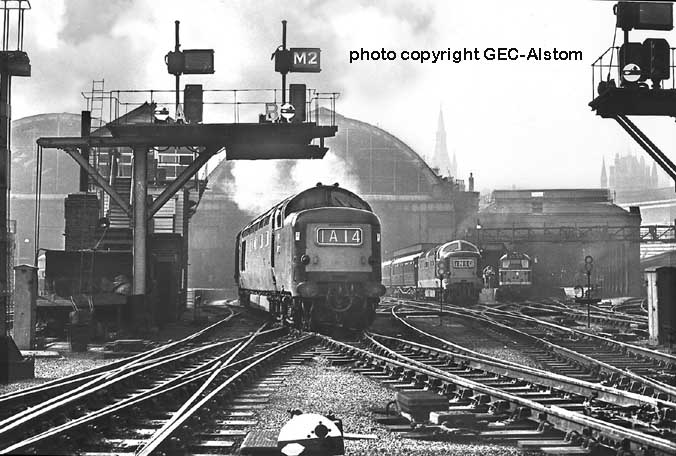
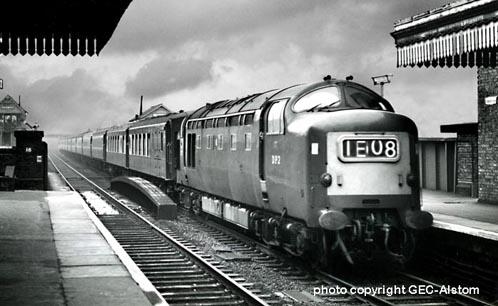
(Above) Prior to receiving the full Deltic livery, the raking light picks out the dumpy proportions of DP2's Deltic-style body shell (in overall dark green) as the prototype speeds through Finsbury Park with the 'up' 'Yorkshire Pullman' in September 1963.
(Below) Sporting its two-tone green livery, DP2 heads the Bradford portion of the 'White Rose Pullman' through Laisterdyke on the run down to Bradford Exchange. DP2 was written off after colliding with derailed cement wagons on the ECML near Thirsk on July 31st 1967. The loco was heading the 11.00 Kings Cross-Edinburgh at between 75-80mph before it hit the obstruction. An updated version of DP2 formed the basis for the D400 class (later Class 50) with flat-fronted cabs as ordered by the BRB.
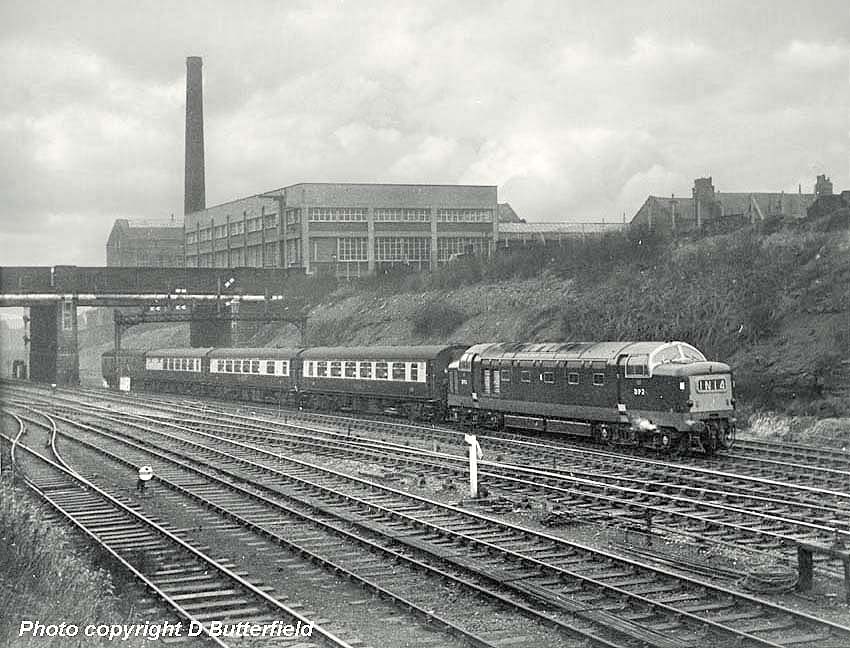
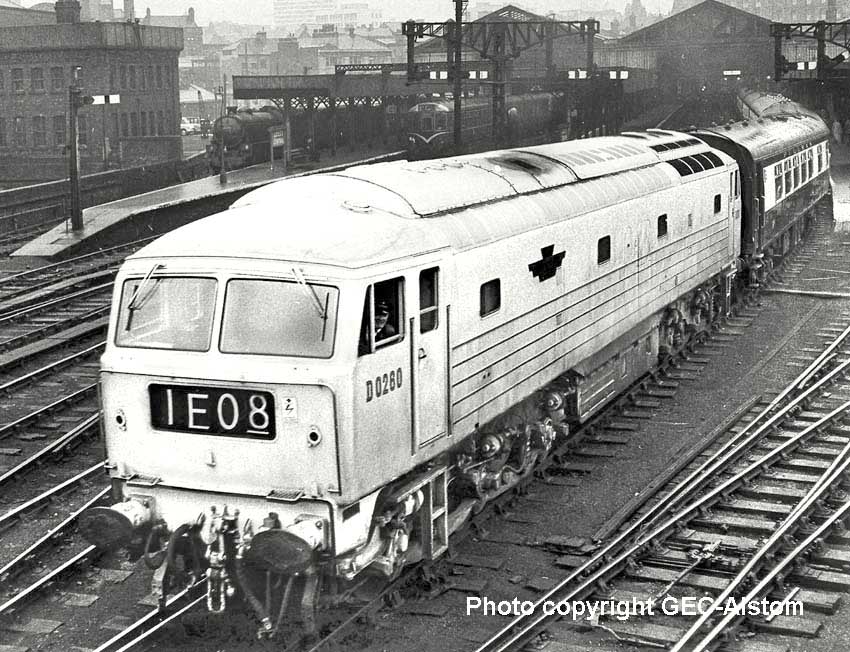
(Above) Another private venture - 'Lion' - was built by a consortium of AEI, BRCW and Sulzer Brothers. The BRCW was responsible for its design and construction, whilst AEI supplied the electrical equipment and Sulzer the 12-cylinder engine, producing a 2,750 hp Co-Co prototype - well within the BTC's specification for a 2,5000hp Type 4. The locomotive entered regular traffic on May 14th 1962, and although BR was greatly attracted to the design, BRCW's financial problems left grave doubts about the company's ability to supply the 2nd-generation Type 4. Unlike DP2, the 'Lion' prototype closely followed the BR design panel's specifications for the new Type 4, using industrial designers Wilkes and Ashmore, consultants for the earlier Brush D5500s, BRCW D5300s Type 2s, and diesel-hydraulic 'Hymek' classes. The BRCW Co's 2,750hp 'Lion' can be seen departing Leeds Central station with the 'up' 'Yorkshire Pullman'.
(Below) Meanwhile, Brush Traction set about the task of developing a prototype Type 4 locomotive, wholly financed and owned by the company, but as there was no single diesel power unit available to produce the required 2,800hp, the company installed two high-speed Bristol-Siddeley/Maybach engines of 1,440hp. Aptly named 'Falcon' (after its builders works) the prototype began trials in BR service working from Finsbury Park depot. The late summer of 1962 saw the end of two chapters in the development of BR main line diesel power. The first was the completion of the EE Co Type 4 D200s with the delivery of D399 - the last of 200 locomotives in the series - and the Type 4 Peak class was concluded at Derby and Crewe with Nos D193 and D57 being the last of the respective batches built there. Also in 1962, 'Falcon' was used regularly on the 'Master Cutler' between Kings Cross and Sheffield, consisting of two round trips a day - 670 miles every 24 hours - albeit the lightweight Pullman of 240 to 320 tons made so little serious demand on a diesel locomotive of such power.
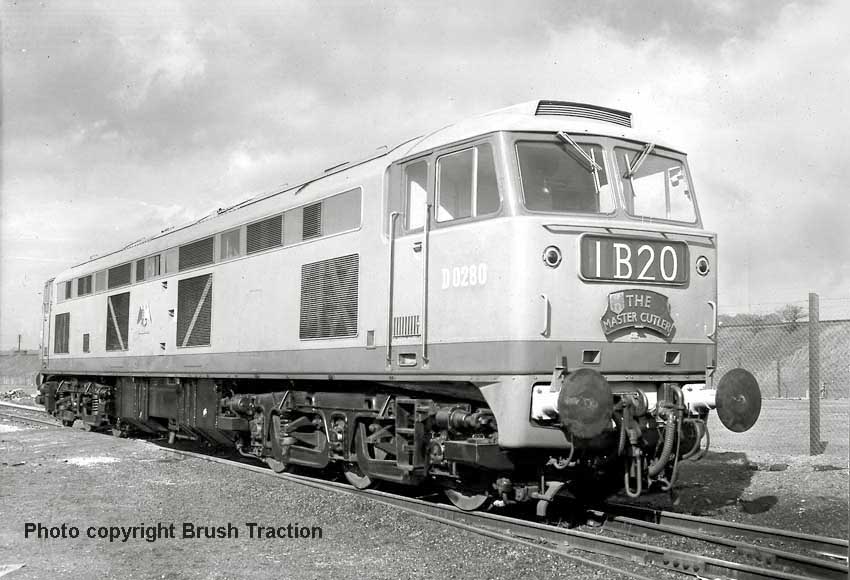
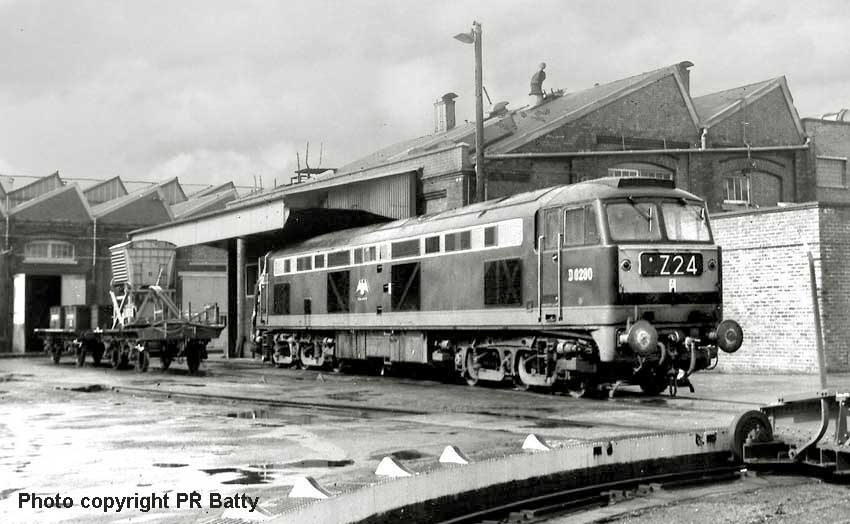
(Above) The original livery of the Brush Falcon gave way to standard BR green and pale grey/green, with yellow warning panels. It was sold to BR in 1971, classified as Class 53 and renumbered D1200. The prototype is seen on the test plant at Swindon on April 24th 1966. Withdrawal came in October 1972.
(Below) Continuing the Brush Traction's theme of birds of prey, another prototype - 'Kestrel' - was conceived in 1965, by which time BR envisaged the need for a new 4,000hp locomotive. An agreement was made with BR to produce a high-powered prototype as a private venture to operate on BR tracks. A single engine had been developed to 4,000hp - the Sulzer 16LVA-24 - and the new electronics used in 'Kestrel' came from the experimental 'Hawk' Bo-Bo (the Brush rebuild of the LMS/ North Br itish Co's No 10800, as mentioned in 'Pioneer Diesel' page). Indeed, from the Hawk experiment emerged the successful ac main generator to replace the heavy dc generators previously used in rail traction. However, all was not well with the new 4,000hp prototype, since the locomotive weighed 133 tons, some 10 tons heavier than the criteria laid down by the BRB. It was formerly handed over for trials in January 1968, but due to its higher than required axle loading of 20 tons, the loco was restricted to tests below full speed and power, spending most of its time on freight duties in the Shirebrook area. Following the replacement of new bogies, an improved 21 tons per axle load was eventually achieved and Kestrel was finally accepted for 100mph passenger operation on the ECML.On October 20th 1969, the Brush/Sulzer 3,946hp 'Kestrel' hauled its first revenue-earning passenger service out of Kings Cross. Sporting streamlined cabs and a pleasing two-tone livery of brown and golden yellow, the driver applies power at the head of the 07.55 Kings Cross-Newcastle.


(Above) As it turned out, 'Kestrel' was not the beginning of a new era on BR, whose latest traction policy was heading towards the introduction of diesel multiple units for high speed trains (HST) and in 1975 the Brush machine was sold to the USSR. Nontheless, many valuable lessons had been learned both by Brush Traction and BR, for the 'Kestrel' prototype was the springboard of many new advances in applied technology for rail traction and the ac generator became widely accepted as standard. Here, Rail Cameraman Trevor Ermel photographs the Brush/Hawker Siddeley 4000hp prototype Kestrel, crossing the King Edward Bridge into Newcastle on 1st November 1969.
(Below) Brush Traction was awarded the contract for the new BR Type 4, and the first of the 2,750hp Sulzer-engined machines No D1500, emerged from the Loughborough works early in September 1962 for acceptance trials, but as the company did not have the capacity to construct sufficient numbers of the new Type 4 fleet, an agreement was made for some machines to be constructed under licence at BR's Crewe workshop. The Brush machines weighed 114 tons, mounted on a Co-Co wheelbase which gave the fleet a much better route availability and enabled them to negotiate tight curves at dead-slow speed - a matter of some considerable importance in sidings and marshalling yards.
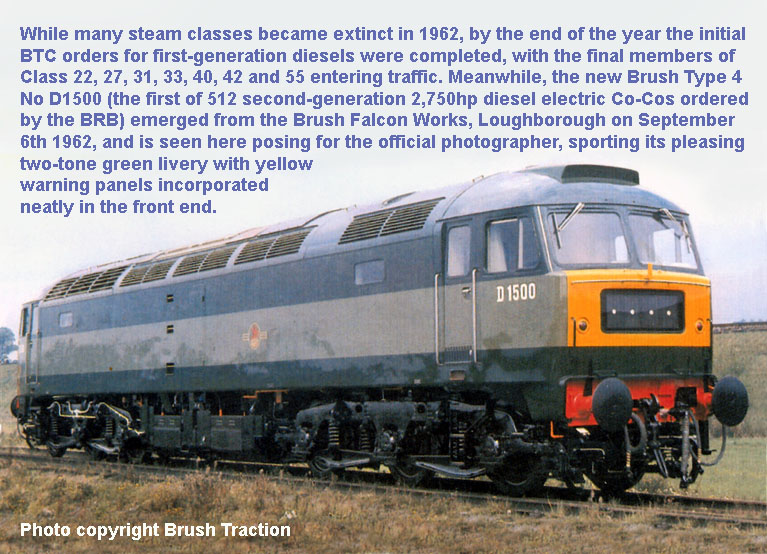
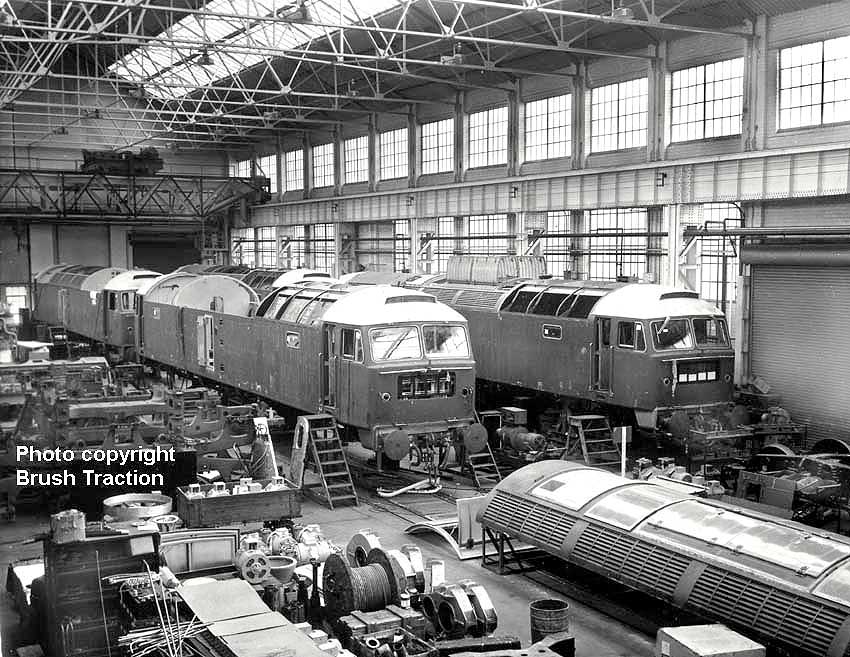
 (Above-Left) This general view of the shopfloor shows several machines in various stages of construction. The neat body lines of the Brush machine was enhanced by grouping all grilles in the roof section at cantrail level, whilst the front ends were a considerable improvement upon the original pilot scheme design, resembling the earlier Brush Falcon prototype. (Left) Looking at this view of the shop floor, one wonders what today's Health & Safety representative would make of it? A daredevil fitter balances precariously on the aluminium cab section windowsill as the glass fibre roof is lowered into place on top of the cab.
(Above-Left) This general view of the shopfloor shows several machines in various stages of construction. The neat body lines of the Brush machine was enhanced by grouping all grilles in the roof section at cantrail level, whilst the front ends were a considerable improvement upon the original pilot scheme design, resembling the earlier Brush Falcon prototype. (Left) Looking at this view of the shop floor, one wonders what today's Health & Safety representative would make of it? A daredevil fitter balances precariously on the aluminium cab section windowsill as the glass fibre roof is lowered into place on top of the cab.
(Right) As the Brush Works at Loughborough was unable to build sufficient numbers of the new Type 4 to meet delivery targets, an agreement was made with BR for Crewe workshops to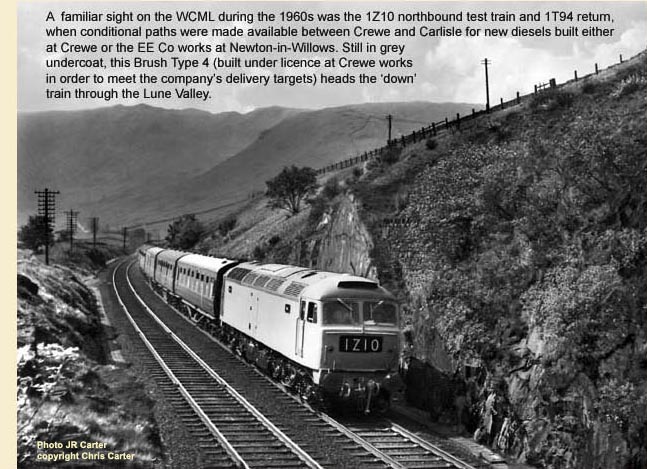 construct some of the locos under licence. A familiar sight on the WCML during the 1960s was the 1Z10 test train, when conditional paths were made available between Crewe and Carlisle for testing new diesels built either at Crewe or the English Electric Co works at Newton-le-Willows. Still in grey undercoat, this Crewe-built Brush Type 4 displays 1Z10 in its four panel route indicator as it heads the northbound test train through the Lune Gorge.
construct some of the locos under licence. A familiar sight on the WCML during the 1960s was the 1Z10 test train, when conditional paths were made available between Crewe and Carlisle for testing new diesels built either at Crewe or the English Electric Co works at Newton-le-Willows. Still in grey undercoat, this Crewe-built Brush Type 4 displays 1Z10 in its four panel route indicator as it heads the northbound test train through the Lune Gorge.
(Below) With less than a year to go before the cessation of steam, Crewe-built Brush Type 4 No D1815 heads the return 1T94 test train south through Carnforth on the return leg to Crewe. I take this to be an accurate description, however among the most prolific contributors to spot inaccuracies on this site is ex-BR Fleet Engineer, Vic Smith, who writes - 'D1815 was a Loughborough-built loco (Feb 65), which this could well be, as it is fitted with oval builders plate and horizontal opening tail lamps. But it is definitely not a test train as there is a goods brake van immediately behind the locomotive and I don't think it would ride very well at 90mph!
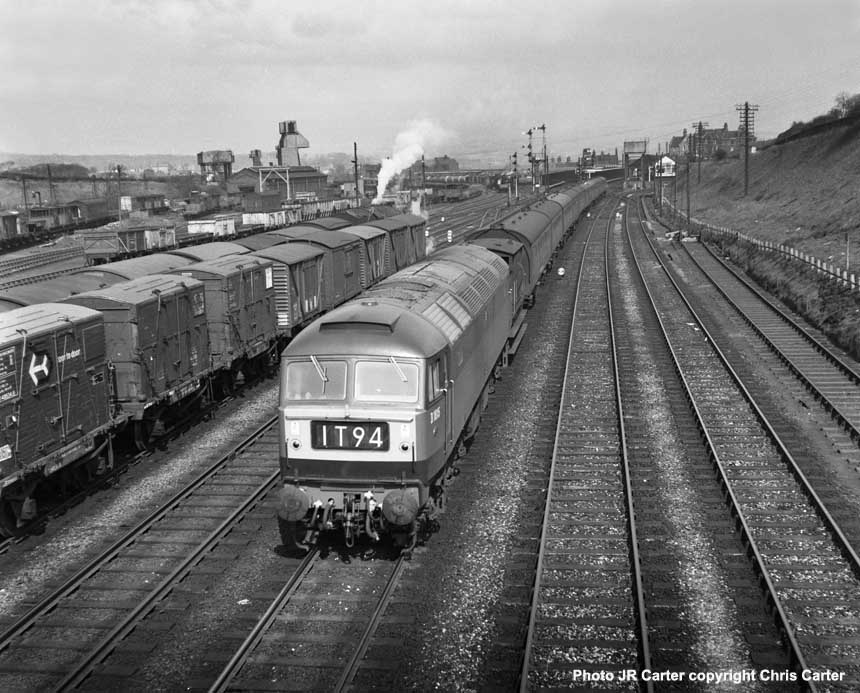
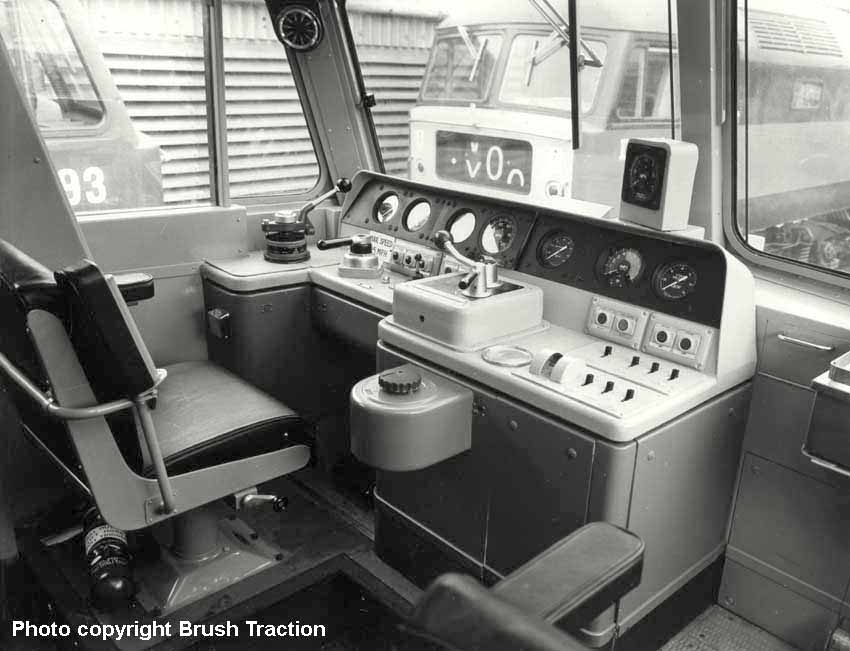
(Above) It was only natural that railmen had an in-built loyalty towards steam traction, therefore the new fangled diesels were not too welcome by them. During the transitional years BR was faced with the task of converting thousands of railmen to a new, and often, unwelcome way of thinking. But any steam loyalties were soon dispelled under the influence of a comfortable diesel cab! After all, a driver could enjoy upholstered seating, smoother riding, excellent visibility and effortless power could be extracted from the engine without physically exhausting himself or his fireman. Compared to the sweat and labour of the steam footplate the diesel cab was a luxury, and many a girth widened as a result. The Brush Type 4 was designed subsequent to the pilot-scheme diesels therefore the cab incorporated many improvements to the earlier cab interiors.

(Above) A nameplate 'Vulcan' from Brush Type 4 D1676, went under the hammer for £4,000 at a Great Western Railwayana Auction in May 2013. Built at the BR Crewe Works in May 1965 and allocated new to Cardiff Canton, D1676 was named without ceremony at the shed in October 1965. The plate was in original ex-loco condition with traces of blue paint around the edge.
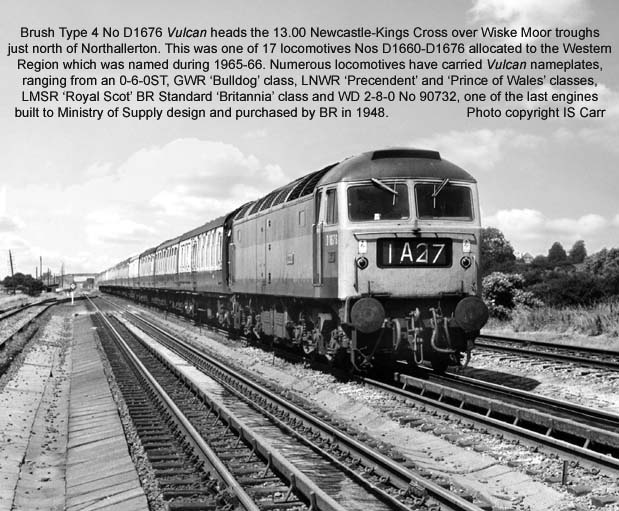

(Above) The fleet of 2,750hp Class 50s, Nos D400-D449, were the production development of the EE Co's prototype DP2, and made their debut in 1967 as a stopgap for the WCML pending completion of the 25kV electrification between Weaver Junction and Glasgow. Dubbed 'Hoovers' by enthusiasts (due to the arrangement of the air intake fans which produced a rather distinctive sound) these locomotives appeared in an overall rail blue livery with full yellow ends; black buffer beam, bogies and undergear, together with the barbed-wire logo (indicating two-way traffic) which the BRB adopted in place of the British lion and wheel symbol. Yet to turn a wheel in revenue-earning service, No D403 awaits acceptance trials at the EE Co works at Newton-in Willows.
(Below) By the time the Class 50s were transferred to the Western Region in the late Seventies, a decade of 100mph main line running on the WCML had taken its toll on the class, and in 1979 Doncaster Works began a major refurbishing programme which was essentially a complete rebuild of the fleet. The work included removal of the rheostatic brakes and slow speed control, modification of brake cylinders, re-equipping the main electrical equipment and overhaul of the EE 16-cylinder turbo-charged power units. The appearance of the outshopped 50s showed little sign of this massive undertaking, except for the replacement of redundant headcode panels by translucent maker discs, a high density headlight was fitted in the cab front and the recessed roof line was modified to accommodate a new roof fan - plus, of course, a startling new livery. The new livery was devised by BRB's Industrial Design Department following a request by BR's Chairman for a more imposing livery for main line diesels. Compared to the overall blue livery and full yellow ends of the corporate identity scheme, the new 'large body logo' style sat very well on the bulk of the Class 50. The good looks of the EE Co machine can be seen in this shot of No 50045 Achilles seen passing Holgate Junction with the 09.50 Edinburgh-Plymouth on 3rd Sept 1981 - a regular diagram for outshopped 50s returning to the WR.
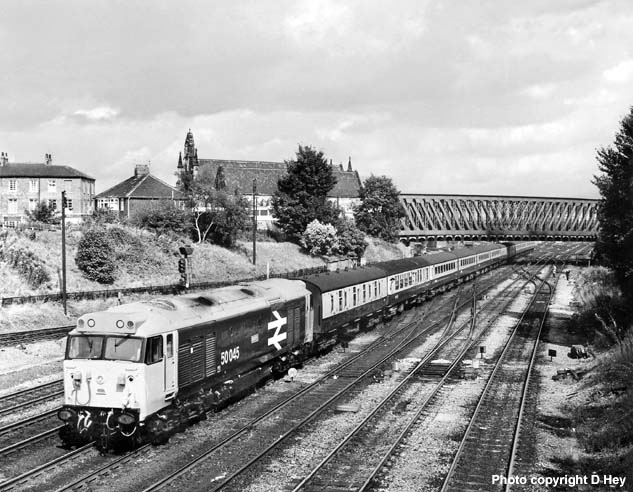
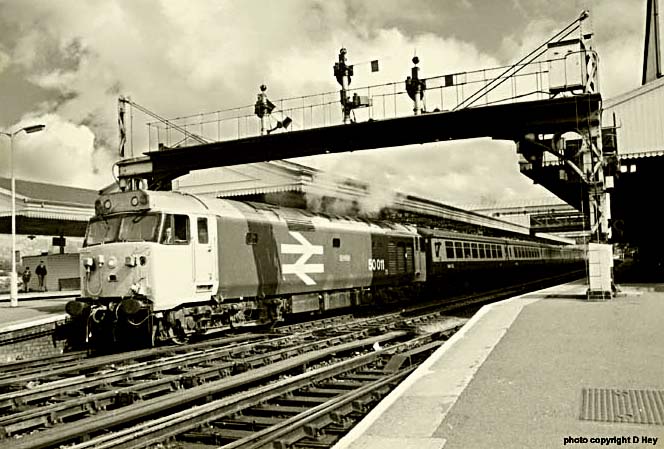
(Above-Below) After photographing the end of the Deltics' reign on the ECML in January 1982, the new large logo'd Class 50 livery reawakened an interest in photographing trains in the Eighties. When the Class 50s arrived on the Western Region they were given names of British navy warships, many previously carried by the WR's diesel-hydraulic class D800s during the Sixties. At the same time, with the installation of more modern multiple aspect signalling (MAS) serious students of railway history set about photographing the old-fashioned manual boxes and their attendant signal installations, many dating back to pre-grouping days, before they vanished from the scene. Framed by Exeter's aged gantry on the 'down' main platform, No 50011 Centurian restarts a Paddington-Plymouth train from Exeter. (Below) Looking more like a rail tour, Hoover fans hang from the window of the 12.50 Paignton-Paddington behind No 50049 Defiance at Teignmouth in July 1981.
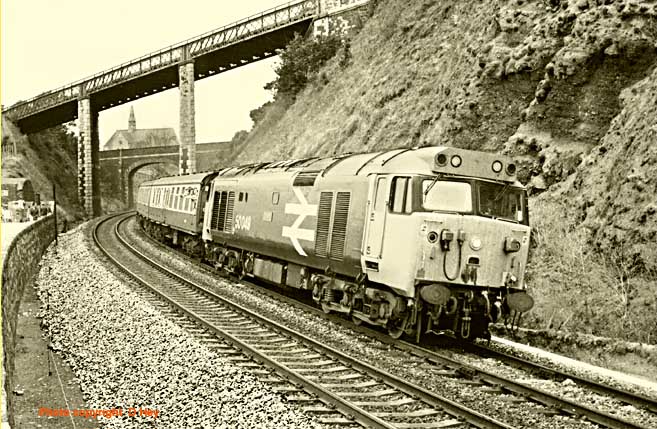
FOOTNOTE: THE SECOND GENERATION DIESELS ARE FEATURED ON PAGE 40 & PAGE 41.
Polite notice: All text and photographs are protected by copyright and reproduction is prohibited without the prior consent of the © owners. If you wish to discuss using the contents of this page the email address is below. Please note - this is not a 'clickable mail-to link via Outlook Express:
dheycollection@ntlworld.com
The English Electric Co's candidate for the new Type 4 was DP2 - Diesel Prototype 2 - which emerged from the EE Co Vulcan Foundry in May 1962. It was essentially an enlarged version of the EE Co Type 3 Co-Co (later Class 37) the extra power being provided by the company's charged-cooled version of the 16-cylinder 16SVT engine uprated to 2,750hp.

(Above) Here DP2 is sporting the production 'Deltic'-type bodyshell (in overall green livery) with modifies louvers, and is seen heading the 'up' 'Manxman' through Rugby in July 1962. (Below) During trials on the LMR based at Camden shed DP2 passed its first year on a diagram covering a remarkable 3,600 miles per week, but in view of the LMR's impending electrification between Euston, Liverpool and Manchester, the loco was transferred to the ECML. During the summer of 1963, DP2 regularly covered 5,270 miles per week between Kings Cross and Edinburgh, taking the 10.10 each weekday from Kings Cross and returning overnight on the 22.30 from Edinburgh. As it turned out, DP2 was the most intensely utilized of the prototype Type 4s, which led to an order for fifty locomotives (Class 50) the first EE Co design to eliminate the characteristic nose ends on the company's Class 55, 37 and Class 40 fleet.
(Below) The privately-sponsored EE Co prototype DP2 was employed on the ECML to cover for the withdrawal of the Deltic fleet for train heating boiler modifications. Despite the rigorous Type 5 schedules, DP2 had a similar trouble-free spell of service as it had done on the WCML. Here the prototype is seen departing Kings Cross with the 9.50 for Newcastle on September 23rd 1963. Photo © GE-Alstom


(Above) Prior to receiving the full Deltic livery, the raking light picks out the dumpy proportions of DP2's Deltic-style body shell (in overall dark green) as the prototype speeds through Finsbury Park with the 'up' 'Yorkshire Pullman' in September 1963.
(Below) Sporting its two-tone green livery, DP2 heads the Bradford portion of the 'White Rose Pullman' through Laisterdyke on the run down to Bradford Exchange. DP2 was written off after colliding with derailed cement wagons on the ECML near Thirsk on July 31st 1967. The loco was heading the 11.00 Kings Cross-Edinburgh at between 75-80mph before it hit the obstruction. An updated version of DP2 formed the basis for the D400 class (later Class 50) with flat-fronted cabs as ordered by the BRB.


(Above) Another private venture - 'Lion' - was built by a consortium of AEI, BRCW and Sulzer Brothers. The BRCW was responsible for its design and construction, whilst AEI supplied the electrical equipment and Sulzer the 12-cylinder engine, producing a 2,750 hp Co-Co prototype - well within the BTC's specification for a 2,5000hp Type 4. The locomotive entered regular traffic on May 14th 1962, and although BR was greatly attracted to the design, BRCW's financial problems left grave doubts about the company's ability to supply the 2nd-generation Type 4. Unlike DP2, the 'Lion' prototype closely followed the BR design panel's specifications for the new Type 4, using industrial designers Wilkes and Ashmore, consultants for the earlier Brush D5500s, BRCW D5300s Type 2s, and diesel-hydraulic 'Hymek' classes. The BRCW Co's 2,750hp 'Lion' can be seen departing Leeds Central station with the 'up' 'Yorkshire Pullman'.
(Below) Meanwhile, Brush Traction set about the task of developing a prototype Type 4 locomotive, wholly financed and owned by the company, but as there was no single diesel power unit available to produce the required 2,800hp, the company installed two high-speed Bristol-Siddeley/Maybach engines of 1,440hp. Aptly named 'Falcon' (after its builders works) the prototype began trials in BR service working from Finsbury Park depot. The late summer of 1962 saw the end of two chapters in the development of BR main line diesel power. The first was the completion of the EE Co Type 4 D200s with the delivery of D399 - the last of 200 locomotives in the series - and the Type 4 Peak class was concluded at Derby and Crewe with Nos D193 and D57 being the last of the respective batches built there. Also in 1962, 'Falcon' was used regularly on the 'Master Cutler' between Kings Cross and Sheffield, consisting of two round trips a day - 670 miles every 24 hours - albeit the lightweight Pullman of 240 to 320 tons made so little serious demand on a diesel locomotive of such power.


(Above) The original livery of the Brush Falcon gave way to standard BR green and pale grey/green, with yellow warning panels. It was sold to BR in 1971, classified as Class 53 and renumbered D1200. The prototype is seen on the test plant at Swindon on April 24th 1966. Withdrawal came in October 1972.
(Below) Continuing the Brush Traction's theme of birds of prey, another prototype - 'Kestrel' - was conceived in 1965, by which time BR envisaged the need for a new 4,000hp locomotive. An agreement was made with BR to produce a high-powered prototype as a private venture to operate on BR tracks. A single engine had been developed to 4,000hp - the Sulzer 16LVA-24 - and the new electronics used in 'Kestrel' came from the experimental 'Hawk' Bo-Bo (the Brush rebuild of the LMS/ North Br itish Co's No 10800, as mentioned in 'Pioneer Diesel' page). Indeed, from the Hawk experiment emerged the successful ac main generator to replace the heavy dc generators previously used in rail traction. However, all was not well with the new 4,000hp prototype, since the locomotive weighed 133 tons, some 10 tons heavier than the criteria laid down by the BRB. It was formerly handed over for trials in January 1968, but due to its higher than required axle loading of 20 tons, the loco was restricted to tests below full speed and power, spending most of its time on freight duties in the Shirebrook area. Following the replacement of new bogies, an improved 21 tons per axle load was eventually achieved and Kestrel was finally accepted for 100mph passenger operation on the ECML.On October 20th 1969, the Brush/Sulzer 3,946hp 'Kestrel' hauled its first revenue-earning passenger service out of Kings Cross. Sporting streamlined cabs and a pleasing two-tone livery of brown and golden yellow, the driver applies power at the head of the 07.55 Kings Cross-Newcastle.


(Above) As it turned out, 'Kestrel' was not the beginning of a new era on BR, whose latest traction policy was heading towards the introduction of diesel multiple units for high speed trains (HST) and in 1975 the Brush machine was sold to the USSR. Nontheless, many valuable lessons had been learned both by Brush Traction and BR, for the 'Kestrel' prototype was the springboard of many new advances in applied technology for rail traction and the ac generator became widely accepted as standard. Here, Rail Cameraman Trevor Ermel photographs the Brush/Hawker Siddeley 4000hp prototype Kestrel, crossing the King Edward Bridge into Newcastle on 1st November 1969.
(Below) Brush Traction was awarded the contract for the new BR Type 4, and the first of the 2,750hp Sulzer-engined machines No D1500, emerged from the Loughborough works early in September 1962 for acceptance trials, but as the company did not have the capacity to construct sufficient numbers of the new Type 4 fleet, an agreement was made for some machines to be constructed under licence at BR's Crewe workshop. The Brush machines weighed 114 tons, mounted on a Co-Co wheelbase which gave the fleet a much better route availability and enabled them to negotiate tight curves at dead-slow speed - a matter of some considerable importance in sidings and marshalling yards.


 (Above-Left) This general view of the shopfloor shows several machines in various stages of construction. The neat body lines of the Brush machine was enhanced by grouping all grilles in the roof section at cantrail level, whilst the front ends were a considerable improvement upon the original pilot scheme design, resembling the earlier Brush Falcon prototype. (Left) Looking at this view of the shop floor, one wonders what today's Health & Safety representative would make of it? A daredevil fitter balances precariously on the aluminium cab section windowsill as the glass fibre roof is lowered into place on top of the cab.
(Above-Left) This general view of the shopfloor shows several machines in various stages of construction. The neat body lines of the Brush machine was enhanced by grouping all grilles in the roof section at cantrail level, whilst the front ends were a considerable improvement upon the original pilot scheme design, resembling the earlier Brush Falcon prototype. (Left) Looking at this view of the shop floor, one wonders what today's Health & Safety representative would make of it? A daredevil fitter balances precariously on the aluminium cab section windowsill as the glass fibre roof is lowered into place on top of the cab. (Right) As the Brush Works at Loughborough was unable to build sufficient numbers of the new Type 4 to meet delivery targets, an agreement was made with BR for Crewe workshops to
 construct some of the locos under licence. A familiar sight on the WCML during the 1960s was the 1Z10 test train, when conditional paths were made available between Crewe and Carlisle for testing new diesels built either at Crewe or the English Electric Co works at Newton-le-Willows. Still in grey undercoat, this Crewe-built Brush Type 4 displays 1Z10 in its four panel route indicator as it heads the northbound test train through the Lune Gorge.
construct some of the locos under licence. A familiar sight on the WCML during the 1960s was the 1Z10 test train, when conditional paths were made available between Crewe and Carlisle for testing new diesels built either at Crewe or the English Electric Co works at Newton-le-Willows. Still in grey undercoat, this Crewe-built Brush Type 4 displays 1Z10 in its four panel route indicator as it heads the northbound test train through the Lune Gorge. (Below) With less than a year to go before the cessation of steam, Crewe-built Brush Type 4 No D1815 heads the return 1T94 test train south through Carnforth on the return leg to Crewe. I take this to be an accurate description, however among the most prolific contributors to spot inaccuracies on this site is ex-BR Fleet Engineer, Vic Smith, who writes - 'D1815 was a Loughborough-built loco (Feb 65), which this could well be, as it is fitted with oval builders plate and horizontal opening tail lamps. But it is definitely not a test train as there is a goods brake van immediately behind the locomotive and I don't think it would ride very well at 90mph!


(Above) It was only natural that railmen had an in-built loyalty towards steam traction, therefore the new fangled diesels were not too welcome by them. During the transitional years BR was faced with the task of converting thousands of railmen to a new, and often, unwelcome way of thinking. But any steam loyalties were soon dispelled under the influence of a comfortable diesel cab! After all, a driver could enjoy upholstered seating, smoother riding, excellent visibility and effortless power could be extracted from the engine without physically exhausting himself or his fireman. Compared to the sweat and labour of the steam footplate the diesel cab was a luxury, and many a girth widened as a result. The Brush Type 4 was designed subsequent to the pilot-scheme diesels therefore the cab incorporated many improvements to the earlier cab interiors.

(Above) A nameplate 'Vulcan' from Brush Type 4 D1676, went under the hammer for £4,000 at a Great Western Railwayana Auction in May 2013. Built at the BR Crewe Works in May 1965 and allocated new to Cardiff Canton, D1676 was named without ceremony at the shed in October 1965. The plate was in original ex-loco condition with traces of blue paint around the edge.


(Above) The fleet of 2,750hp Class 50s, Nos D400-D449, were the production development of the EE Co's prototype DP2, and made their debut in 1967 as a stopgap for the WCML pending completion of the 25kV electrification between Weaver Junction and Glasgow. Dubbed 'Hoovers' by enthusiasts (due to the arrangement of the air intake fans which produced a rather distinctive sound) these locomotives appeared in an overall rail blue livery with full yellow ends; black buffer beam, bogies and undergear, together with the barbed-wire logo (indicating two-way traffic) which the BRB adopted in place of the British lion and wheel symbol. Yet to turn a wheel in revenue-earning service, No D403 awaits acceptance trials at the EE Co works at Newton-in Willows.
(Below) By the time the Class 50s were transferred to the Western Region in the late Seventies, a decade of 100mph main line running on the WCML had taken its toll on the class, and in 1979 Doncaster Works began a major refurbishing programme which was essentially a complete rebuild of the fleet. The work included removal of the rheostatic brakes and slow speed control, modification of brake cylinders, re-equipping the main electrical equipment and overhaul of the EE 16-cylinder turbo-charged power units. The appearance of the outshopped 50s showed little sign of this massive undertaking, except for the replacement of redundant headcode panels by translucent maker discs, a high density headlight was fitted in the cab front and the recessed roof line was modified to accommodate a new roof fan - plus, of course, a startling new livery. The new livery was devised by BRB's Industrial Design Department following a request by BR's Chairman for a more imposing livery for main line diesels. Compared to the overall blue livery and full yellow ends of the corporate identity scheme, the new 'large body logo' style sat very well on the bulk of the Class 50. The good looks of the EE Co machine can be seen in this shot of No 50045 Achilles seen passing Holgate Junction with the 09.50 Edinburgh-Plymouth on 3rd Sept 1981 - a regular diagram for outshopped 50s returning to the WR.


(Above-Below) After photographing the end of the Deltics' reign on the ECML in January 1982, the new large logo'd Class 50 livery reawakened an interest in photographing trains in the Eighties. When the Class 50s arrived on the Western Region they were given names of British navy warships, many previously carried by the WR's diesel-hydraulic class D800s during the Sixties. At the same time, with the installation of more modern multiple aspect signalling (MAS) serious students of railway history set about photographing the old-fashioned manual boxes and their attendant signal installations, many dating back to pre-grouping days, before they vanished from the scene. Framed by Exeter's aged gantry on the 'down' main platform, No 50011 Centurian restarts a Paddington-Plymouth train from Exeter. (Below) Looking more like a rail tour, Hoover fans hang from the window of the 12.50 Paignton-Paddington behind No 50049 Defiance at Teignmouth in July 1981.

FOOTNOTE: THE SECOND GENERATION DIESELS ARE FEATURED ON PAGE 40 & PAGE 41.
Polite notice: All text and photographs are protected by copyright and reproduction is prohibited without the prior consent of the © owners. If you wish to discuss using the contents of this page the email address is below. Please note - this is not a 'clickable mail-to link via Outlook Express:
dheycollection@ntlworld.com




